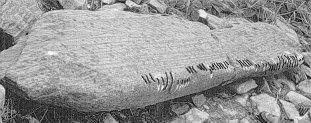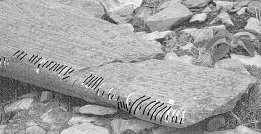Location and history:
 circular stone enclosure" named Cathair na g-cat in the townland of Ballywiheen (Baile Bhóithín according to OSDP, 9 [Irish part]; Baile Uí Bhaoithín according to the OS Discovery Map 70), in Oct. 1855, "covered with rubbish", by one Rev. J. Goodman. It was erected by him and "half a dozen men .. on the top of the Cathair" at the same date (according to Macalister, CIIC, this was done `"for protection"'). On 2.9.1856 it was visited by R. Hitchcock who made a rubbing and "a rough, but accurate, diagram copy of the inscription"; he "was not able to make a sketch of the whole monument", however (PRIA 6, 1856, 439). According to Macalister, CIIC, the stone was smashed into three pieces by a man who was searching for a treasure inside it in the 1890s; the third piece containing the end of the inscription was no longer present when the site was visited by Macalister. At that time, the stone was still standing upright (Epig. 1, 53); it must have been laid (or fallen?) on the ground some time afterwards, as it is now. According to Sheehy, Dingle 22, the third piece was later used as a lintel. When the site was visited in 1981, the inscription had been redrawn for better readability by somebody using chalk; this was no longer present during a second visit in 1998.
circular stone enclosure" named Cathair na g-cat in the townland of Ballywiheen (Baile Bhóithín according to OSDP, 9 [Irish part]; Baile Uí Bhaoithín according to the OS Discovery Map 70), in Oct. 1855, "covered with rubbish", by one Rev. J. Goodman. It was erected by him and "half a dozen men .. on the top of the Cathair" at the same date (according to Macalister, CIIC, this was done `"for protection"'). On 2.9.1856 it was visited by R. Hitchcock who made a rubbing and "a rough, but accurate, diagram copy of the inscription"; he "was not able to make a sketch of the whole monument", however (PRIA 6, 1856, 439). According to Macalister, CIIC, the stone was smashed into three pieces by a man who was searching for a treasure inside it in the 1890s; the third piece containing the end of the inscription was no longer present when the site was visited by Macalister. At that time, the stone was still standing upright (Epig. 1, 53); it must have been laid (or fallen?) on the ground some time afterwards, as it is now. According to Sheehy, Dingle 22, the third piece was later used as a lintel. When the site was visited in 1981, the inscription had been redrawn for better readability by somebody using chalk; this was no longer present during a second visit in 1998.According to OSDP, 9, the stone fort contains "the foundations of at least two round houses", and "there is also a souterrain here". The site is not marked on the OS Discovery Map (70), but the Early Christian enclosure named "An Raingiléis" which is just on the opposite side of the road leading from Ballywiheen to Marhin (Márthain) is marked as a "Láthair Luathré Chríostaí" (OSDM 70: 35.3 / 3.5). For a possible connection with a cross standing in this enclosure and the ringfort containing an Ogham inscribed stone, cf. {193}.
- Published illustrations:
- Hitchcock, PRIA 6, 1856, 440 (
 draft of stone standing upright [sketched by whom?]);
draft of stone standing upright [sketched by whom?]);- Macalister, CIIC 1, 166 (sketch of inscription only,"Ferguson's cast" being used for suppletion of the missing "concluding letters");
- OSDP, 9 (draft).
- Macalister, CIIC 1, 166 (sketch of inscription only,"Ferguson's cast" being used for suppletion of the missing "concluding letters");
Size according to MCIIC ("dimensions taken by Hitchcock when the stone was perfect"): 4'8" x 1'10 1/2" x 0'9", "tapering to 0'10" x 0'3 1/2" at the top".
Reading Brash, OIM 220:
TOGITTACCMAQESAGARETTOS
Reading Ferguson, OI 39 (58.):
TOGITTACCMAQISAGARETTOS
Reading Macalister, JRSAI 27, 1897, 226:
TOGITTACC MAQI SAGARETTOS
Reading Macalister, Epig. 1, 53 (29.):
(i): TOGITTACC
(ii): MAQISAGARET
Reading Macalister, CIIC:
TOGITTACC MAQI SAGARETTOS
("The inscription is .. perfect" except for the missing third piece [covering which part?], "and there has never been any doubt about the reading of the inscription". - "Brash's MAQE is a mistake of his own, and quite unjustifiable".)
Reading Harbison, Guide 112:
TOGITTACC MAQI SAGARETTOS
Reading Sheehy, Dingle 22:
TOGITTACC MAQI SAAGARETTUS
Interpretation Korolev, DP:
TOGITTACC MAQI SAGARETTOS
Reading OSDP, 10:
TOGITTAC MAQI SAGARET(TOS)
Reading Gippert (1981/1998):
Sinister angle,
 "left to
"left to  right":
right":TOGITTACC [M](A)QI SAGARE[T
ᚈᚑᚌᚔᚈᚈᚐᚉᚉ[ᚋ]ᚐᚊᚔᚄᚐᚌᚐᚏᚓᚇ[ᚆ
ᚆᚆᚆᚐᚐᚋᚋᚐᚐᚐᚐᚐᚆᚆᚆᚆᚆᚆᚐᚆᚆᚆᚆᚆᚆᚆᚆ[ᚋ]ᚐᚆᚆᚆᚆᚆᚐᚐᚐᚐᚐᚁᚁᚁᚁᚐᚋᚋᚐᚋᚋᚋᚋᚋᚐᚐᚐᚐᚆᚆ[ᚆ
 end, no traces of what was read as -TOS before could be found; considering that there is no indication of a break, it remains doubtful, though, whether the assumed final part ever existed.)
end, no traces of what was read as -TOS before could be found; considering that there is no indication of a break, it remains doubtful, though, whether the assumed final part ever existed.)- Stokes, Wh., Celt. Decl., 150.